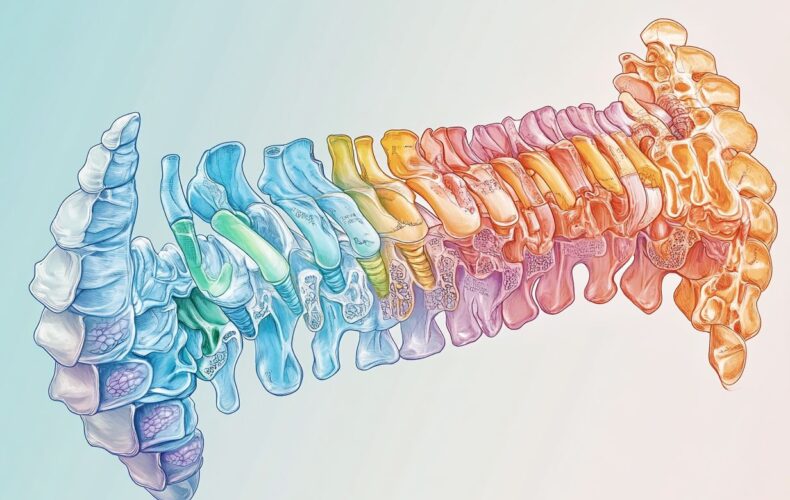Understanding the Anatomy of the Spine: A Detailed Guide
The spine is more than just a crucial structure; it’s the backbone of our entire body, playing a vital role in mobility, stability, and overall health.
This guide will explore the intricate anatomy of the spine, breaking down its essential components, including vertebrae, the spinal cord, and intervertebral discs.
We will also discuss common spine conditions, their symptoms, and effective treatments.
By understanding the spine’s importance and how to maintain its health, you can enhance your well-being and prevent future issues.
Dive in to discover everything you need to know about this remarkable part of the human body!
Overview
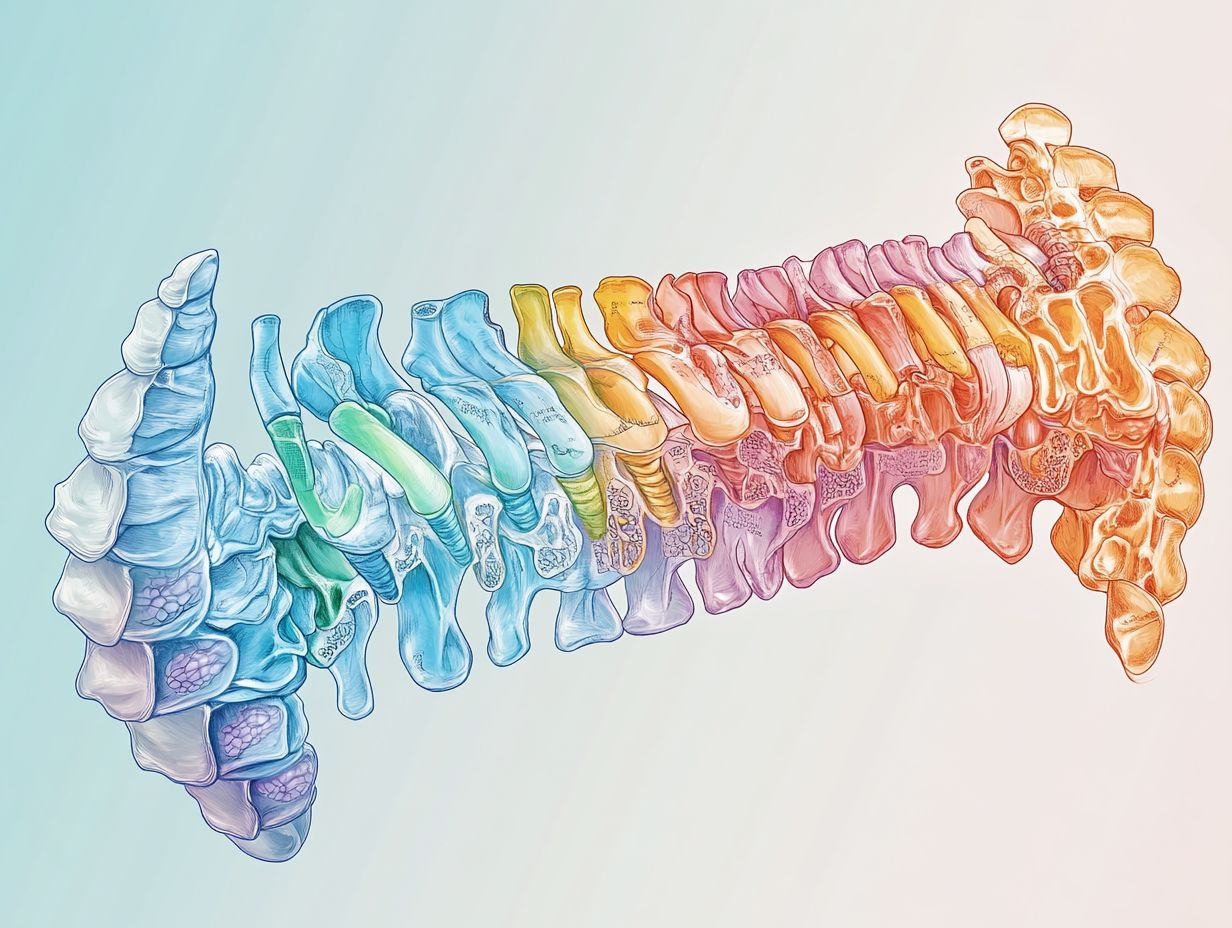
The spine serves as a central pillar of the human body, providing both structure and support while playing a vital role in the overall functionality of numerous bodily systems.
Various spinal conditions, such as back pain and spinal dysfunction, can significantly affect an individual’s quality of life. Consequently, it is essential for individuals to comprehend the importance of spinal health and to seek guidance from qualified spinal health professionals.
What is the spine?
The spine, a crucial element of the human skeletal system, consists of a series of vertebrae that serve to protect the spinal cord while providing both structural support and flexibility to the body.
This complex column is typically composed of 33 individual vertebrae, which are categorized into five distinct regions: cervical, thoracic, lumbar, sacral, and coccygeal. Each vertebra fulfills a specific function; for instance, the cervical vertebrae support the head and facilitate its range of motion, while the thoracic and lumbar regions are responsible for bearing a significant portion of the body’s weight during movement and physical activities.
The intervertebral discs, situated between each vertebra, function as shock absorbers, enabling the vertebrae to withstand pressure while also allowing for flexibility and movement. This remarkable anatomical structure not only protects the spinal cord, thereby minimizing the risk of injury to this vital component of the central nervous system, but also plays an essential role in maintaining overall posture and balance within the body.
Importance of the spine in the human body
The spine is essential for maintaining the structural integrity of the body, facilitating both mobility and flexibility, while also providing protection for the spinal cord, which is crucial for communication between the brain and the rest of the body.
Its function extends to supporting overall posture, which can significantly influence an individual’s presence and behavior in everyday life. Maintaining optimal spinal health not only prevents discomfort and injuries but also enhances the capacity to engage in physical activities, ranging from basic movements to complex athletic endeavors.
The alignment of the spine is critical in balancing bodily systems, thereby impacting overall wellness. By prioritizing the care of this vital structure, individuals can improve their quality of life and ensure the effective functioning of their nervous system, ultimately promoting a healthier and more active lifestyle.
Anatomy of the Spine
The anatomy of the spine comprises several interrelated components, including vertebrae, intervertebral discs, the spinal cord, and associated spinal structures. Each of these elements plays a vital role in the overall function and health of the spine.
Location of the spine
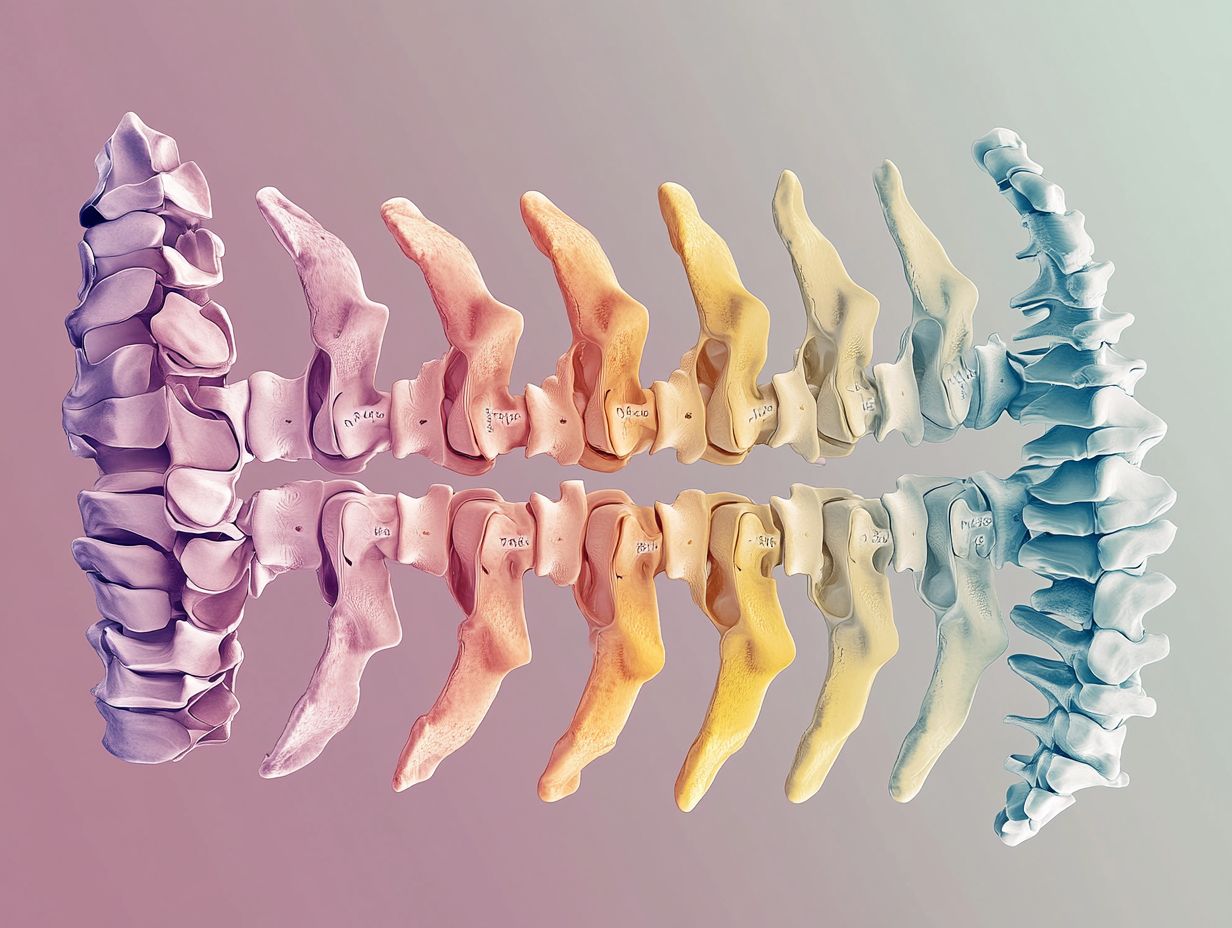
The spine is centrally located within the human body, extending from the base of the skull to the pelvis, and is categorized into distinct regions: the cervical spine, thoracic spine, lumbar spine, sacrum, and coccyx. Each of these segments plays a vital role in maintaining overall skeletal health and supporting bodily functions.
The cervical spine, composed of seven vertebrae, facilitates a considerable range of motion and supports the head while housing essential nerves that affect sensory and motor functions in the upper body.
Descending further, the thoracic spine, which consists of twelve vertebrae, provides protection for vital organs through the ribcage and supports proper posture. The lumbar spine, consisting of five vertebrae, bears a significant portion of the body’s weight and is essential for movements involving lifting and twisting.
Finally, the sacrum and coccyx form the base of the spine, offering stability and serving as strong attachment points for muscles and ligaments that enable movement.
Parts of the spine
The spine consists of several integral components, including vertebrae, intervertebral discs, the spinal cord, spinal joints, and spinal ligaments, each of which is essential to the overall function and health of the spine.
The vertebrae, arranged in a stacked configuration, form the supportive structure of the backbone, while the intervertebral discs function as shock absorbers, cushioning the vertebrae during various movements. The spinal cord acts as a vital conduit for nerve signals, facilitating communication between the brain and the rest of the body. Spinal joints contribute to flexibility and movement, allowing for a wide range of physical activities. Spinal ligaments provide stability by anchoring the vertebrae together, thereby ensuring a robust framework that protects the delicate structures within.
Understanding these interrelated components is crucial for promoting optimal spinal health and preventing injury.
Vertebrae
Vertebrae are the bony structures that constitute the spine, categorized into three primary regions: cervical vertebrae, thoracic vertebrae, and lumbar vertebrae, each possessing distinct anatomical characteristics and functions.
These specialized bone segments play essential roles in maintaining both spinal stability and mobility. The cervical vertebrae, consisting of seven segments, support the head and facilitate a wide range of motion, including nodding and rotation. In contrast, the twelve thoracic vertebrae serve as attachment points for the ribs, contributing to the rib cage’s role in protecting vital organs while also providing limited mobility to support an upright posture.
The five lumbar vertebrae are larger and specifically designed to bear significant weight, enabling bending and lifting movements while ensuring balance and structural integrity. Collectively, these vertebral categories form a flexible yet stable column that safeguards the spinal cord, a critical component of the central nervous system.
Spinal cord and nerves
The spinal cord is a crucial structure situated within the spinal canal, functioning as the principal pathway for transmitting nerve signals between the brain and the body. Spinal nerves extend from the cord to innervate various tissues.
This complex assembly of neural fibers not only facilitates communication between the central nervous system and peripheral regions but also plays a significant role in reflex actions that occur nearly instantaneously. For example, when a hand contacts a hot surface, the spinal cord processes this sensory information and elicits an immediate response, allowing for rapid withdrawal from potential harm.
The overall function of the spinal cord is essential for maintaining bodily coordination, balance, and voluntary movements, underscoring its critical role in both simple and complex physiological activities.
Muscles and ligaments
The muscles and ligaments surrounding the spine provide essential support and stability, with core muscles playing a critical role in maintaining spinal alignment and function. Spinal ligaments contribute by connecting the vertebrae and restricting excessive movement.
These structures operate in unison to ensure that the spine remains both flexible and stable, thereby facilitating a wide range of motion while simultaneously protecting against injuries. Well-developed core muscles not only improve balance and coordination but also reduce stress on the spinal column during physical activities. Conversely, ligaments are vital in preventing hyperextension and other injuries by limiting the range of motion between the vertebrae.
Collectively, these components are fundamental to overall spinal health. Therefore, it is imperative to engage in regular strength and flexibility training to promote well-being and prevent issues such as back pain or dislocation.
Intervertebral discs
Intervertebral discs are specialized structures situated between each vertebra, serving as shock absorbers that contribute to spinal flexibility and facilitate smooth movement while promoting spinal health.
These discs are composed of a robust outer layer known as the annulus fibrosus, which encases a gel-like core referred to as the nucleus pulposus. This distinctive design enables them to endure considerable pressure during various activities, such as lifting and twisting.
By cushioning the vertebrae, intervertebral discs help mitigate the risk of injuries and degenerative conditions, such as herniated discs, which can significantly impair mobility. Additionally, these discs play a vital role in maintaining overall posture by providing essential support to the spinal column.
A thorough understanding of their anatomy and function is imperative for individuals seeking to enhance their spinal health and preserve a full range of motion.
Facet joints
Facet joints are small articulations situated between the vertebrae that facilitate spinal mobility, allowing for smooth movements and flexibility throughout the spine.
These joints are essential for maintaining a stable yet dynamic structure, enabling the spine to endure various forces during activities such as bending, twisting, and lifting. The alignment and health of these facet joints are critical in preventing pain and discomfort, thereby significantly influencing an individual’s overall quality of life.
Each facet joint, which connects one vertebra to another, not only supports a wide range of motion but also restricts excessive movement that could result in injury, thereby underscoring their importance in the intricate balance of spinal anatomy. Consequently, the proper functioning of these joints is vital for optimal spinal health.
Function of the Spine
The spine performs several essential functions, including providing structural support to the body, enabling flexibility and mobility, protecting the spinal cord, and facilitating movement through its interconnected vertebrae and joints.
What does the spine do?
The spine plays a critical role in providing structural support for the body, facilitating upright posture, enabling movement, and safeguarding the spinal cord from injury.
This remarkable structure serves as the central pillar of the body, anchoring the skull while allowing for the rotation of the head. Additionally, it functions as a crucial conduit for the nerves that connect the brain to various parts of the body.
Through its intervertebral discs, the spine effectively absorbs shocks and permits flexibility, facilitating essential activities such as bending, twisting, and reaching. The intricate design of the spinal column also supports the surrounding muscles, ligaments, and organs, thereby ensuring overall stability and balance.
Furthermore, its protective bony encasement is vital for safeguarding the delicate spinal cord, which is essential for transmitting signals necessary for various bodily functions.
Role of spinal curvature
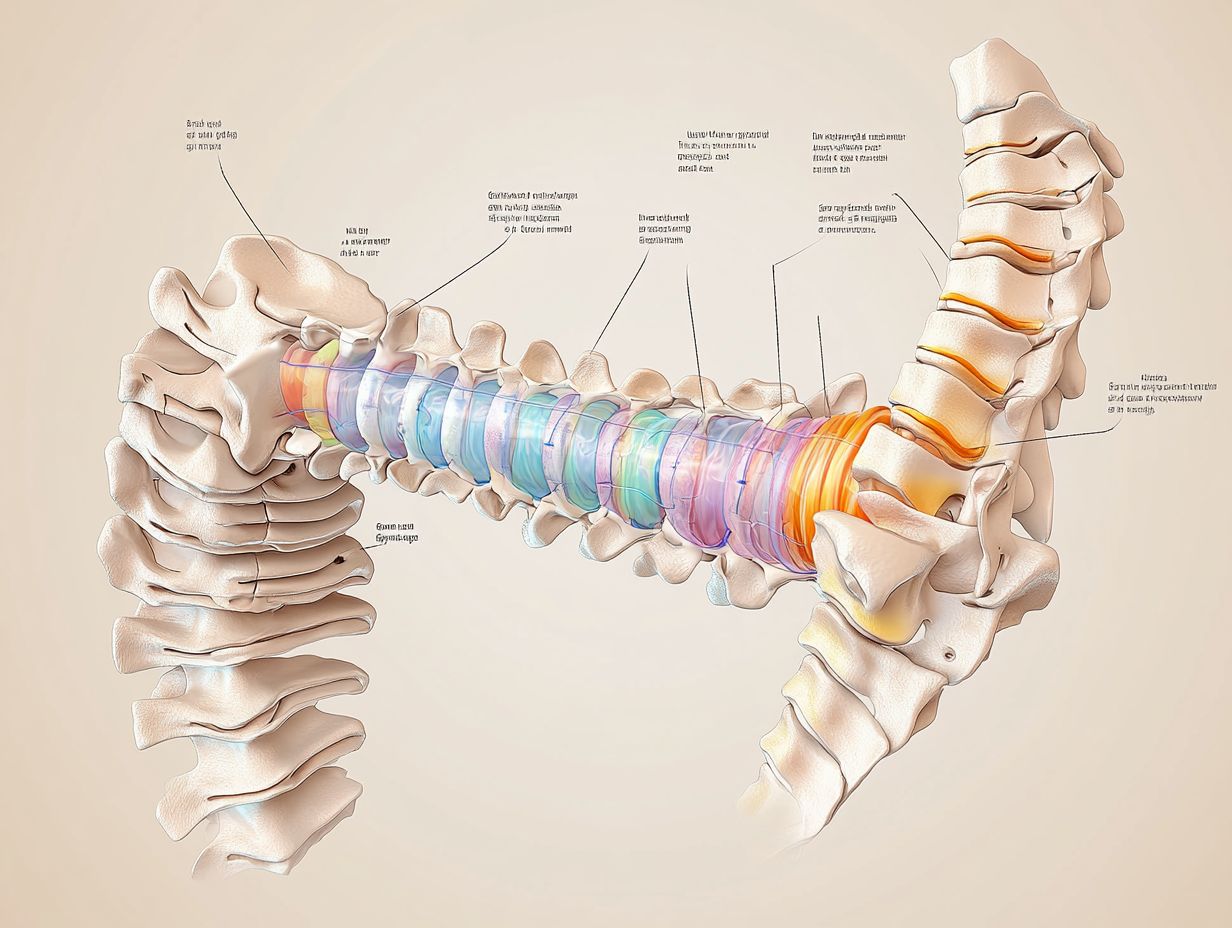
The natural curves of the spine, which include the cervical, thoracic, and lumbar curves, are essential for maintaining spinal health. They facilitate flexibility and shock absorption during movement.
These curves serve not only as structural elements but also as vital components that distribute the weight of the upper body, thereby ensuring efficient force transfer during various activities, such as walking, running, and even routine tasks like bending or lifting.
When these curves are balanced and well-maintained, they contribute to improved posture and reduce the risk of injuries associated with strains or overexertion. Conversely, abnormalities in spinal curvature can result in discomfort, pain, and a decline in mobility, highlighting the necessity of regular assessments and the implementation of practices such as stretching, strengthening exercises, and ergonomic adjustments.
A comprehensive understanding of these anatomical nuances is crucial for promoting optimal spinal function and overall well-being.
Conditions and Disorders
A variety of conditions and disorders can impact the spine, resulting in issues such as back pain, degenerative disc disease, herniated discs, and overall spinal dysfunction.
These conditions may significantly impede mobility and diminish quality of life.
Common conditions affecting the spine
Common conditions affecting the spine encompass back pain, radiculopathy, sciatica, and spinal injuries, each presenting distinct challenges and symptoms that require appropriate attention and care.
Back pain frequently manifests as either a dull ache or sharp discomfort, significantly impacting daily activities and potentially leading to chronic conditions if not addressed in a timely manner.
Radiculopathy is characterized by radiating pain, numbness, or weakness that occurs when nerve roots are compressed or irritated, often as a result of herniated discs or spinal stenosis.
Sciatica specifically refers to pain that travels along the sciatic nerve, typically originating from a herniated disc, and can result in substantial mobility limitations.
Spinal injuries, which may include fractures or whiplash, have the potential to drastically diminish an individual’s quality of life and require immediate medical intervention to prevent long-term damage to spinal health.
Symptoms of spine-related issues
Symptoms associated with spine-related issues may present as back pain, spinal discomfort, or tailbone pain, frequently impacting mobility and daily activities.
These discomforts can often be accompanied by additional signs such as stiffness, tingling sensations, or radiating pain into the limbs, which may disrupt sleep patterns and concentration. As these issues progress, individuals may find that even simple tasks, such as bending or lifting, become increasingly challenging, potentially diminishing both physical health and emotional well-being.
It is essential to recognize these symptoms at an early stage; failing to address them may result in chronic pain conditions that significantly impair one’s overall quality of life. By seeking timely intervention, whether through physical therapy, medication, or lifestyle modifications, individuals can effectively reclaim their mobility and restore their daily routines with greater ease and comfort.
Treatment options for spine conditions
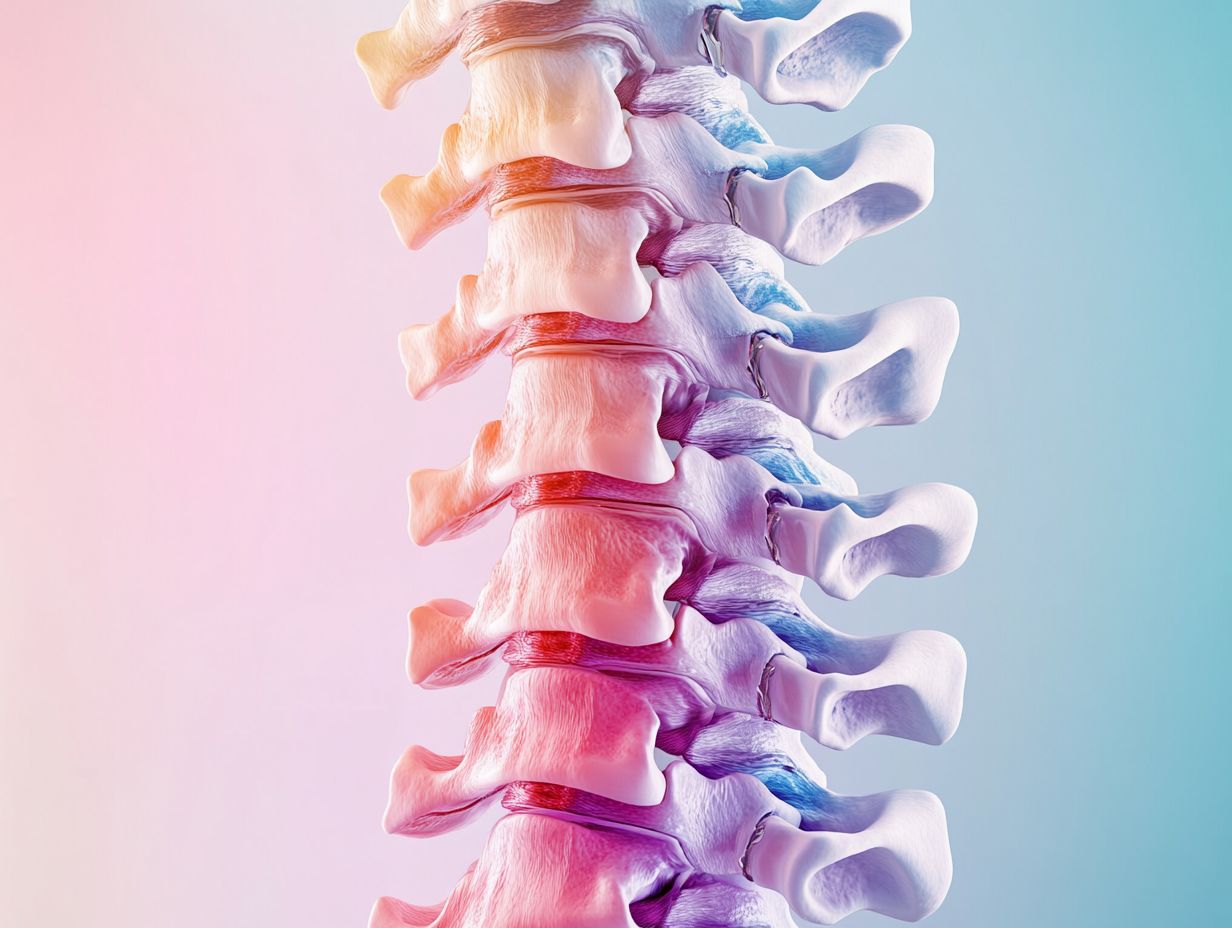
Treatment options for spine conditions may encompass physical therapy, spinal strengthening exercises, medication, and consultations with spinal health professionals aimed at restoring mobility and managing pain.
Along with these foundational approaches, emerging therapies such as chiropractic manipulation and epidural steroid injections can significantly enhance relief for numerous individuals.
Patients frequently discover that a multidisciplinary strategy yields optimal results, integrating conservative methods with advanced techniques, including minimally invasive surgeries when deemed necessary.
Furthermore, lifestyle modifications, including ergonomic improvements and specific dietary adjustments, can play a pivotal role in a patient’s overall recovery journey.
Thus, exploring the full spectrum of available treatments ensures tailored care that effectively addresses the unique needs of each individual affected by spine conditions.
Maintaining Spine Health
Maintaining spinal health is essential for ensuring a healthy and functional body. This can be effectively achieved through regular spinal exercises, back strengthening routines, and the implementation of proper spinal support during daily activities.
How to keep your spine healthy
To maintain optimal spinal health, it is imperative to engage in regular spinal exercises, uphold proper posture, and integrate back strengthening activities into one’s routine.
By prioritizing these components, individuals can significantly diminish the risk of developing back pain and other spinal-related issues. Incorporating exercises such as cat-cow stretches can effectively enhance <b:flexibility and promote proper spinal alignment.</b:flexibility
Furthermore, activities such as planks and bridges not only strengthen the core, which is essential for spinal stability, but also aid in ensuring correct spinal alignment during daily activities.
In addition, incorporating gentle yoga or Pilates routines can further enhance overall spinal health by fostering awareness of posture and encouraging relaxation. By committing to these practices, individuals can cultivate a balanced approach to maintaining a resilient and healthy spine.
When to seek medical advice
It is essential to seek medical advice from spinal health professionals when experiencing persistent back pain or symptoms related to spinal injuries that disrupt daily life.
Such symptoms may include numbness, tingling sensations in the arms or legs, weakness, or even chronic headaches, all of which can significantly affect an individual’s quality of life. Furthermore, individuals may observe difficulties in performing routine tasks, increased discomfort during physical activities, or alterations in mobility.
By recognizing these warning signs early, proactive steps can be taken to maintain spinal health.
Consulting with a specialist not only addresses immediate concerns but also assists in preventing potential complications, thereby ensuring a comprehensive approach to well-being and functionality.
Summary of key points
This guide offers a comprehensive overview of the anatomy and function of the spine, as well as the conditions that can impact spinal health, thereby emphasizing the importance of proactive care.
Within these pages, readers will gain valuable insights into the complex structure of the spinal column, its crucial role in overall body mechanics, and the ways in which various ailments—such as herniated discs, scoliosis, and degenerative disc disease—can affect daily life.
By understanding these elements, individuals will come to recognize the significance of regular check-ups, appropriate exercises, and lifestyle modifications designed to maintain spinal integrity.
Engaging in preventative measures is essential not only for alleviating discomfort but also for enhancing overall well-being and mobility as one ages.
Ultimately, prioritizing spinal health can fundamentally transform one’s approach to physical fitness and daily activities.
Final thoughts on spine health
Maintaining the health of the spine is essential for overall physical well-being, and gaining an understanding of its anatomy and function enables individuals to take proactive measures in preserving spinal health.
A well-functioning spine is integral to supporting the body’s structure, facilitating movement, and protecting the central nervous system. Neglecting spinal health can result in a variety of issues, including chronic pain, reduced mobility, and potential impacts on mental clarity.
Thus, it is imperative to educate oneself on the importance of proper posture, engage in regular exercise, and practice mindful weight management to enhance spinal health. Incorporating activities such as yoga or physical therapy can significantly contribute to maintaining spinal integrity.
Ultimately, prioritizing spinal health not only improves physical capabilities but also enriches overall quality of life, motivating individuals to take active steps toward long-term wellness.
